Avoiding Arrogance While Evangelizing
A video on how to share the truth of the faith.

An outline and script for a guided meditation before the Blessed Sacrament in the tabernacle. Have you explored Go Seek Find: Discover God’s Treasures yet? This one-of-a-kind sacrament prep program will help children discover how preparing for the sacraments is …
The video "Jesus Urging His Disciples to Stay Awake," by Turnback to God, available on YouTube (5:32), is an animated account of Jesus at prayer in Gethsemane (an amalgamation of Gospel accounts). It is best used on day 4.

This handout provides questions for students to reflect on and answer as they read quotations from this Constitution.

On this handout, students match the meaning to each line of the Lord’s Prayer.

On this handout, students must use clues to unscramble words related to prayer.

This handout guides students as they locate and read various Scripture passages focusing on the many way God calls us to prayer.

Students look up and read several passages that the Holy Spirit. The worksheet asks students to summarize each passage and describe the role of the Holy Spirit in spreading the Good News.

Students look up and read several miracle stories from the New Testament before identifying common points between them.

This handout helps provides the dialogue for the students to renew their baptismal promises as a class.
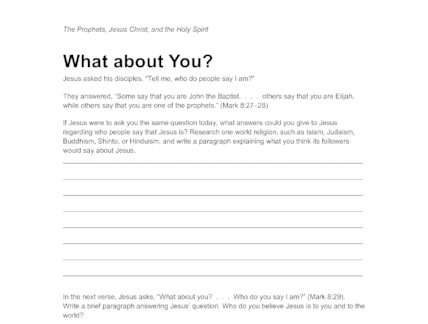
After reading Mark 8:27-29, students must answer several questions about who Jesus is to today’s world and people.

Students must look up several Scripture passages that give insight into the disciples of Jesus. This worksheet poses questions that help make Jesus’ mission relatable to students.
The song/video "Burning in My Soul," by Matt Maher, available on YouTube (3:45), provides a nice connection to Pentecost and the modern listener and is appropriate for use on day 4.
The song/video "Forever (Live)," by Kari Jobe, available on YouTube (6:50) with lyrics, is a good opening prayer for day 4. The video can be shortened to 4:38.
The video "Resurrection Cartoon," available on YouTube (3:05), offers a fun portrayal of the Resurrection and is appropriate for use on day 1.
The video "The Prodigal," by The Skit Guys, available on YouTube (7:27), is an engaging retelling of the Lost Son story for the day 3 lesson.
The song/video "Call It Grace," by Unspoken, available on YouTube (4:00), is appropriate for use on day 3.
The song/video "Holy, Holy, Holy," by Steven Curtis Chapman, available on YouTube (4:54), is a contemporary version of the classic hymn and can be used for prayer or meditation on day 2.
The video "Matthew 1:1–16: The Genealogy of Jesus Christ," available on YouTube (2:19), is an animation of the lineage of Jesus that shows his connection to the tribe of Judah (see 0:18). It is used on day 3.
The video “Samson: The Final Judge,” by Meaningful Jewish Screentime, available on YouTube (6:57), is an entertaining, animated version of the story of Samson. It is appropriate for use on day 4.
The video “Deborah’s Army: The Book of Judges,” by Meaningful Jewish Screentime, available on YouTube (3:02), is an entertaining, animated version of Judges, chapter 4. It is appropriate for use on day 3.
The song/video “We Delight,” by Caedmon’s Call, available on YouTube (3:27), is a praise song about God’s Law. It is appropriate for use on any of the days.
The video “Mysteries: The Trinity,” available on YouTube (22:57), presented by several Catholic priests and theologians, would be good preparation for teaching this chapter.
The video “The Trinity (Christian Triune Godhead) Explained Part 1,” available on YouTube (3:55), is a good introduction to the Trinity, but it might be challenging for some young adolescents. There is also a part 2 that explains some common …
The video “The Trinity (Christian Triune Godhead) Explained Part 1,” available on YouTube (3:55), is a good introduction to the Trinity, but it might be challenging for some young adolescents. There is also a part 2 that explains some common …
The song/video “How Great Is Our God,” by Chris Tomlin, available on YouTube (4:27) with lyrics, is a contemporary song that gives praise to God as Father, Son, and Holy Spirit. It would be a nice introduction to God’s greatness …
The video "The Parable of the Unforgiving Servant," by Matthew Abeler, available on YouTube (5:26), is best used on day 2.
The cartoon "The Parable of the Unforgiving Servant," available on YouTube (1:42), is best used on day 2.
This PowerPoint accompanies Chapter E by giving a summary of the stories of Rebecca, Ruth, Judith, and Esther.
This PowerPoint accompanies Chapter C by giving a summary of the stories of Joshua, Deborah, and Samson.
This PowerPoint accompanies Chapter B by giving a summary of the story of Moses and the Exodus.
This PowerPoint accompanies Chapter 7 by exploring what it means to be human.
This PowerPoint accompanies Chapter 6 by exploring creation and the existence of evil.
This PowerPoint accompanies Chapter 4 by exploring the central mystery of the Catholic faith: the Trinity.
This PowerPoint follows along with the concepts presented in Chapter 3 of The Old Testament and the Trinity.
This PowerPoint follows along with the concepts presented in Chapter 2 of The Old Testament and the Trinity.
This PowerPoint follows along with the concepts presented in Chapter 1 of The Old Testament and the Trinity.

This worksheet helps students to reflect on the numerous images of the lamb found in Scripture.
This supplemental PowerPoint accompanies Unit 1 by providing an introduction to Salvation History.
This supplemental PowerPoint summarizes Unit 1 by discussing how God reveals himself to us through nature.
This supplemental PowerPoint summarizes Unit 1 by discussing how God reveals himself to us.
This PowerPoint accompanies Unit 1, Chapter 3 by exploring how God has revealed Himself to us through Jesus Christ, Scripture, and Tradition.
This PowerPoint accompanies Unit 1, Chapter 2 by exploring how God is revealed to us in the beauty and perfection of His creation.
This PowerPoint accompanies Unit 1, Chapter 1 by exploring our desire to know God and how best to do so.

This handout presents two project possibilities to assess student understanding of the concepts learned in Unit 2.

This Mind Map helps students to organize and brainstorm ideas about friends, school, sports, and family.

This is a journal prompt which asks students to reflect on times when they have been given advice.
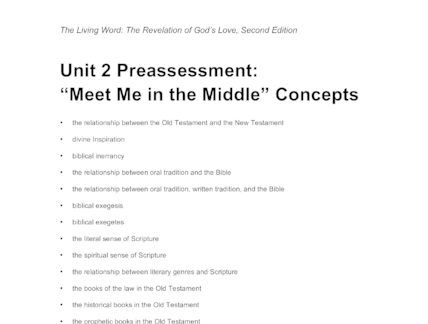
This preassessment lists many key concepts to be covered in Unit 2.

This is a self-evaluation to help students reflect on their learning during Unit 1.

This is the rubric to evaluate student’s final projects for Unit 1.

This handout provides two project possibilities to assess student understanding of the concepts covered in Unit 1.

This is a description for an art project where students express the relationship between Sacred Scripture and Sacred Tradition.

This handout provides a set of guidelines and instructions to help students successfully participate in a Socratic seminar.

This assignment helps students to create a poem of praise about an object in nature.

This project asks students to research an exemplary model of what it means to be the best person that God created each of us to be.
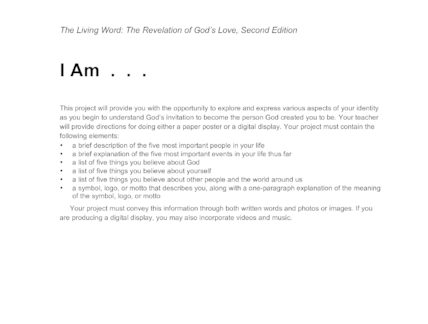
This is a project description that asks students to create a poster as they explore their identity.

This preassessment poses questions about how students have come to know God.

This is a list of articles and other sources to accompany student learning as they discover who is Jesus Christ.
This PowerPoint accompanies Unit 5, Chapter 16, by discussing what our response to Jesus is as we pursue eternal life with Him.
This PowerPoint accompanies Unit 4, Chapter 12, by discussing our call to holiness as told by Jesus’ parables and teachings.
This PowerPoint accompanies Unit 4, Chapter 11, by discussing God’s plan for each of us as His children.
<p>This PowerPoint accompanies Unit 4, Chapter 10, by discussing the inherent dignity of all life as shown to us by Jesus.</p>
This PowerPoint accompanies Unit 4, Chapter 9, by discussing Jesus’ example of what it means to live as a perfect human being.
This PowerPoint accompanies Unit 3, Chapter 8, by discussing Jesus’ presence in Church history and today.
This PowerPoint accompanies Unit 3, Chapter 7, by discussing the society and life of Jesus and how it these related to the nature of his humanity and divinity.
This PowerPoint accompanies Unit 3, Chapter 6, by discussing the Incarnation, which brought about the full connection of humanity and divinity.
This PowerPoint accompanies Unit 2, Chapter 4, by discussing the revelation of God through creation, prayer, and the saints.
This PowerPoint accompanies Unit 2, Chapter 4, by discussing the revelation of God through Scripture and Tradition.
<p>This PowerPoint accompanies Unit 2, Chapter 3, by discussing the relationship between God and humans.</p>
This PowerPoint accompanies Unit 1, Chapter 2, by discussing the development of Trinitarian Doctrine in the early church.
This PowerPoint accompanies Unit 1, Chapter 1 by discussing the mystery of the Trinity.
This PowerPoint reflects on faith and how it ties in with religion and beliefs.
This PowerPoint reflects on what it means to be human and uses Jesus as the model of how to live well.
This PowerPoint presents images of some of Jesus’ parables and asks students to reflect on and recall each one.
This PowerPoint looks at the Greatest Commandment and how it summarizes all of Jesus’ teachings.
This PowerPoint presents common questions and doubts about the existence of God before showing the way to sources that provide guidance.
This PowerPoint explores the ways we look for God and the numerous places God reveals himself to us.
This PowerPoint identifies the three persons of the Trinity.
This PowerPoint covers the development of Trinitarian Theology during the early church.
This PowerPoint reflects on the statements of faith in the Trinity found in the Nicene Creed.
This PowerPoint provides an introduction to the mystery of the Trinity in the Catholic faith.

This is the evaluation tool for the two final-project possibilities for Unit 5.

This handout lists two final-project possibilities for Unit 5.

This handout lists Scripture passages to be read by students that reference eternal life and how Jesus makes it possible for us to attain it.

This worksheet helps students to take notes as they read articles and make connections to the principles of Catholic Social Teaching.

This handout asks students to complete a chart by listing examples of discipleship at the time of Jesus and today.

This preassessment for Unit 5 asks students to identify how faith, religion, discipleship, and prayer are important to their relationship with God.

A rubric to assess the two final project options for Unit 4.

This handout provides two project options that allow students to demonstrate their understanding of the concepts learned in Unit 4.

This handout challenges students to reflect on the application of the greatest commandment in their own lives.

This worksheet provides questions for students to reflect on and answer while watching a movie.

This handout poses questions and gives statements that challenge to think about what it means to be fully human and how Jesus exemplified that in his life.
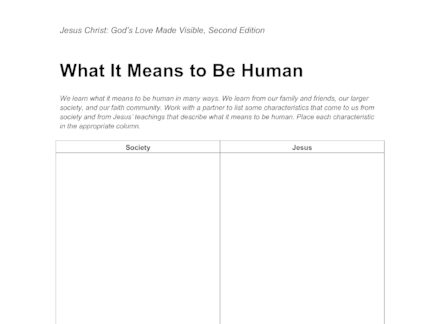
This handout helps students list characteristics that come from society and from Jesus’ teachings that describe what it means to be human.
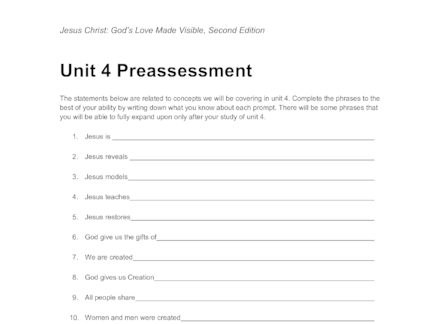
This preassessment asks students to complete phrases about the concepts to be covered in Unit 4.

This is the rubric for two projects designed to assess student understanding of the concepts presented in Unit 3.

This handout presents two projects to assess student understanding of the concepts presented in Unit 3.
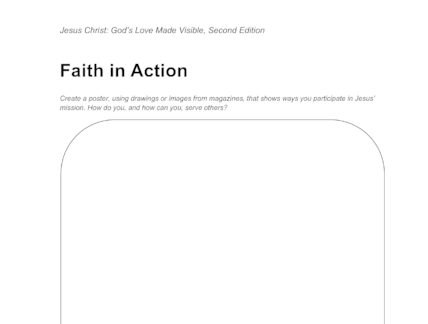
This handout challenges students to create a poster representing the ways they participate in Jesus’ mission to serve others.

This handout asks students to list examples of people in their lives that are serving the community in the various Christian vocations.

After reading several articles, students complete this chart by filling in key points about Jesus and the Church.

Students look up various Bible passages to create an understanding of who Mary was.

This is a list of terms and definitions to be learned and used in Unit 3.

This preassessment identifies student understanding of the concepts to be presented in Unit 3.

This rubric evaluates the two final-project possibilities for Unit 2.
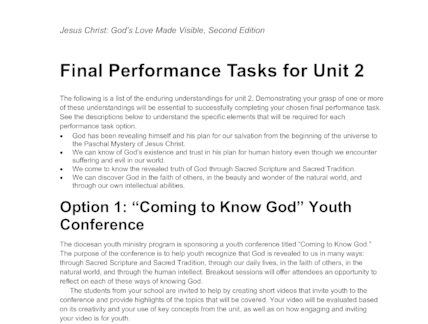
This handout presents two final-project possibilities for Unit 2.

Students think of examples when they have experienced or discovered God in creation.

Students create a storyboard to show how God is revealed in Sacred Tradition.

This handout provides an outline for students to record key points taught by other groups from this section.

This is a list of words and definitions to be learned throughout Unit 2.

This preassessment helps students identify what they know and want to know about concepts from Unit 2.

This handout asks a series of questions to help students reflect on and evaluate the learning in a particular unit.

This is a rubric to assess the final project options for Unit 1.

Two possible projects to assess student understanding of concepts learned in Unit 1.

This handout provides a chart for students to list key relationships that are from their church, community, family, and friends.

This handout breaks down the Nicene Creed line-by-line and gives each a brief explanation and commentary.

This worksheet has students fill in blanks from Chapter 2, Section 6-8, focusing on the faith changes during the early Church centered on the Trinity.

This preassessment for Unit 1 guides students to reflect on their previous knowledge of and what they would like to learn about the Trinity.

A lesson plan for lesson 14 in The Catholic Faith Handbook for Youth: Catechist Guide.

A lesson plan for lesson 13 in The Catholic Faith Handbook for Youth: Catechist Guide.

A lesson plan for lesson 12 in The Catholic Faith Handbook for Youth: Catechist Guide.

A lesson plan for lesson 11 in The Catholic Faith Handbook for Youth: Catechist Guide.

A lesson plan for lesson 10 in The Catholic Faith Handbook for Youth: Catechist Guide.

A lesson plan for lesson 9 in The Catholic Faith Handbook for Youth: Catechist Guide.

A lesson plan for lesson 8 in The Catholic Faith Handbook for Youth: Catechist Guide.

A lesson plan for lesson 6 in the Catholic Faith Handbook for Youth: Catechist Guide.

A lesson plan for lesson 5 in The Catholic Faith Handbook for Youth: Catechist Guide.

A lesson plan for lesson 4 in The Catholic Faith Handbook for Youth: Catechist Guide.

This worksheet presents a list of names for Jesus taken from Scripture. Students examine the meaning and purpose for each title.

An individual worksheet where students rank the priority Jesus placed on certain values in his ministry

A partial list of scripture references for Jesus’ miracles, parables, important teachings, and life events

This handout offers a brief look at the use of Isaiah’s visions of the kingdom during Advent.

Jesus has just risen from the tomb. Although you and all the other Christians are overjoyed, you now have to decide what to do. You are one of the followers who has been with Jesus for more than two years. …

For each statement below, use your Bible to find at least three stories from the life of Jesus that support each theme. Write the citation of the stories under their respective statement, and be sure to tell which sacrament is …

Read each of the following Scripture passages and explain in writing how they each give insight into Jesus’ prayer life.

The Incarnation, a core doctrine of Christianity, states that in Jesus Christ, God became fully human while remaining fully divine. In the Gospel of John, chapter 1, verses 1 through 18, we see one of the earliest expressions of that …

The chart below contains several phrases that the textbook uses to describe Jesus. Take a few minutes to study these phrases, and place a check mark to the left of the one or two that most closely match your own …

Correlation to Curriculum Framework Course III: The Mission of Jesus Christ (The Paschal Mystery) from The Paschal Mystery: Christ’s Mission of Salvation.

Correlation to Curriculum Framework Course II: Who Is Jesus Christ? from Jesus Christ: God’s Love Made Visible.
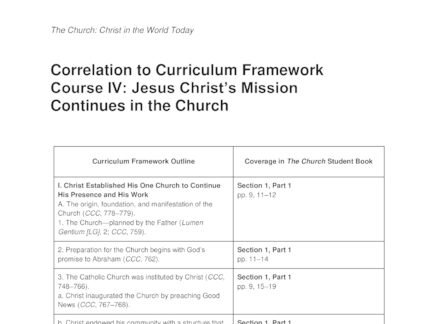
Correlation to Curriculum Framework Course IV: Jesus Christ’s Mission Continues in the Church from The Church: Christ in the World Today.
A personal reflection on how Jesus’ life, death, resurrection, and ascension save us from sin and death and bring us to new life in him.
A personal story about turning to Jesus for help and loving others unconditionally, just as Jesus loves us.
A quick, two-minute video from Busted Halo that explains why we celebrate Advent and wait to celebrate Christmas.
This two-minute video from Busted Halo describes the final week of Lent that we spend preparing for Easter.

A summary of Chapter 24, End Things: Heaven and Hell from the Catholic Connections Handbook for Middle Schoolers, Second Edition.

A summary of Life Issues B: Friends in Jesus from the Catholic Connections Handbook for Middle Schoolers, Second Edition.

One of the symbols the Church uses to represent Christ’s Resurrection is the lily. This beautiful white flower comes to life in the spring, reborn from a lifeless bulb. It resembles a trumpet, an instrument used to announce important news, …

A summary of Chapter 16, The Resurrection of Jesus from the Catholic Connections Handbook for Middle Schoolers, Second Edition.

Decorate the cross shape below with symbols that represent Jesus’ suffering and death. Refer to the Stations of the Cross on page 165 in the handbook. Choose two of the symbols you have drawn. Tell why you chose each symbol …

A summary of Chapter 15, The Death of Jesus from the Catholic Connections Handbook for Middle Schoolers, Second Edition.

Match column A with column B to complete the sentences about Jesus’ healing ministry.

A summary of Chapter 14, Jesus Heals from the Catholic Connections Handbook for Middle Schoolers, Second Edition.

A summary of Chapter 13, Jesus Teaches from the Catholic Connections Handbook for Middle Schoolers, Second Edition.

A summary of Chapter 12, The Birth of Jesus from the Catholic Connections Handbook for Middle Schoolers, Second Edition.

Recall times when you received unexpected good news, either of an everyday nature—such as getting a better grade than you expected on a test—or on a far bigger, perhaps life-changing, scale. Describe an example of each of these types of …

A summary of Chapter 11, Jesus Christ, True God and True Man from the Catholic Connections Handbook for Middle Schoolers, Second Edition.

A summary of Chapter 10, The Bible: The Prophets from the Catholic Connections Handbook for Middle Schoolers, Second Edition.
A personal story about being intentional about our Christian discipleship.
A personal story about the mission of the Church to share the good news of salvation with others.
A PowerPoint on The Catholic Faith Handbook for Youth, Third Edition Chapter 11, Jesus’ Resurrection.
A PowerPoint on The Catholic Faith Handbook for Youth, Third Edition Chapter 10, Jesus’ Death.
A PowerPoint on The Catholic Faith Handbook for Youth, Third Edition Chapter 9, Jesus’ Message and Mission.
A PowerPoint on The Catholic Faith Handbook for Youth, Third Edition Chapter 8, Jesus Christ: True God and True Man.
A PowerPoint on The Catholic Faith Handbook for Youth, Third Edition Chapter 7, The Promise of a Messiah.
A PowerPoint on The Catholic Faith Handbook for Youth, Third Edition Chapter 5, God Our Father.
A PowerPoint on The Catholic Faith Handbook for Youth, Third Edition Chapter 2, Knowing God: Reason and Revelation.

Activities for Chapter 11 Jesus’ Resurrection, including a core activity, core activity extension, and additional activities.

Activities for Chapter 10 Jesus’ Death, including a core activity, core activity extension, and additional activities.

Activities for Chapter 9 Jesus’ Message and Mission, including a core activity, core activity extension, and additional activities.

Activities for Chapter 8 Jesus Christ: True God and True Man, including a core activity, core activity extension, and additional activities.

Read the passage listed under “Forgiveness and Salvation,” and then read your assigned passages from Matthew, Mark and John, or Luke, and answer the questions as your teacher has directed, either in writing (on a separate sheet of paper) or …

Questions about how we can imitate Jesus’ example in the way we interact with others.

Questions about Scripture verses that talk about forgiveness and salvation.

The lesson learning objectives and content summary for Lesson 11, Jesus’ Resurrection.

The lesson learning objectives and content summary for Lesson 10, Jesus’ Death.

Read and discuss the meaning of the parable your group was assigned from the list below. Use this question to guide your discussion: What lesson was Jesus trying to teach about the Kingdom or about our relationship with the Kingdom …

The lesson learning objectives and content summary for Lesson 9, Jesus’ Message and Mission.

Choose three of the Scripture passages below to look up and read. After reading each one, discuss with your group what it says about Jesus’ identity. Write down a summary of your discussion below the saying.

The lesson learning objectives and content summary for Lesson 8, Jesus Christ: True God and True Man.

The lesson learning objectives and content summary for Lesson 7, The Promise of a Messiah.

The lesson learning objectives and content summary for Lesson 5, God our Father.

The lesson learning objectives and content summary for Lesson 3, The Bible’s Big Picture.

The lesson learning objectives and content summary for Lesson 2, Knowing God: Reason and Revelation.

Questions about Bible passages where Jesus teaches how to live.

We believe that because we are transformed by faith in the Risen Jesus, his presence in the world becomes more visible through us. Read the following statements that are based on Jesus’ teachings, and then answer the questions that follow. …

The narrative of Jesus’ passion according to the Gospel of John.

A rubric for the final performance task options for Unit 3 focusing on the Paschal Mystery, the Holy Spirit and the Church, and the mission of the Church. The options include exploring one important ministry in a diverse Church, creating …
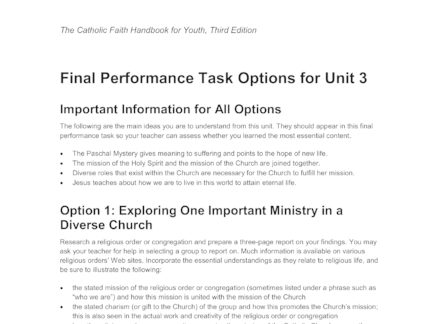
The final performance task options for Unit 3 focusing on the Paschal Mystery, the Holy Spirit and the Church, and the mission of the Church. The options include exploring one important ministry in a diverse Church, creating a poster comparing …

Answer each question by writing what you know for sure, what you think you know but are unsure about, and things related to the topic that you would like to explore.

Answer the following questions with your group that are related to the questions asked in the song “One of Us”. Your instructor will lead you through Part II. Use the following questions as prompts for taking notes in your notebook.

All of the Scripture passages used in this exercise are taken from the list in your student book (pages 81–82). These Scripture passages concern covenants or promises that provide an image of hope in a future messiah. As you answer …